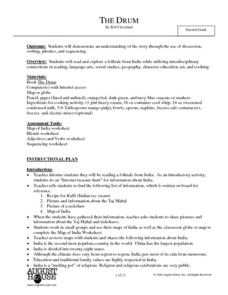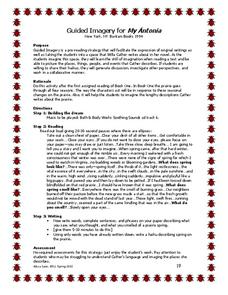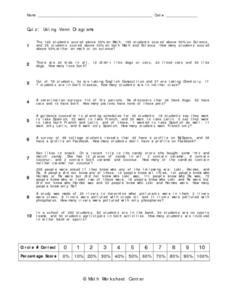Curated OER
Leveled Vocabulary for And Then There Were None
Chaotic, perjury, tenacious, vague, predatory, idiosyncrasy. Using Marzano and Brown’s six steps of direct instruction for vocabulary (choose, restate, illustrate, use, discuss, play) readers of And Then There Were None engage in a...
Spark Notes
And Then There Were None by Agatha Christie: Study Guide - Mini Essays
In this online interactive literature worksheet, students respond to 8 short answer and essay questions about Agatha Christie's And Then There Were None. Students may check some of their answers online.
Curated OER
And Then There Were None Quiz
In this online interactive reading comprehension worksheet, students respond to 25 multiple choice questions about Agatha Christie's And Then There Were None. Students may submit their answers to be scored.
Curated OER
Persuasive Letter - And Then There Were None
Students read And Then There Were None by Agatha Christie and write a persuasive letter based on the novel. In this novel analysis and letter writing lesson, students read the story and write a persuasive letter inviting someone to their...
Curated OER
Book Review: And Then There Were None
Students complete a book review for Agatha Christie's And Then There Were None. In this book review lesson, students read the book and discuss how to write a book review. Students follow the format and write the book review.
Curated OER
And Then There Were None by Agatha Christie
Students will explore And Then There Were None by Agatha Christie. For this analysis lesson, students read And Then There Were None and take notes about the book as they read. Students write a plot summary of the book.
Curated OER
Descriptive Paper - And Then There Were None
Pupils explore And Then There Were None by Agatha Christie. In this characterization lesson, students locate passages that contain character descriptions and settings. Pupils write a descriptive essay on the characters in And Then...
Curated OER
Literary Analysis - And Then There Were None
Students explore And Then There Were None by Agatha Christie. In this analysis lesson, students review the definition of literary analysis and read the book. Students then write a literary analysis of the book and include...
K5 Learning
Ten Little Cookies
First there were ten cookies and then there were none. Who ate all the cookies? After reading a short poem that counts down from 10 as cookies are eaten, class members respond to four comprehsnion questions.
Curated OER
Writing a Short Story with
In a previous lesson not included here, class members read Agatha Christie’s And Then There Were None and then wrote a persuasive letter inviting someone to an island. Young sleuths use these letters as basis for a suspenseful short...
August House
The Drum
Take a journey to India with a read aloud of The Drum: A Folktale from India by Rob Cleveland. Make connections to the story's theme by building and practicing drums, role playing story characters, and practicing skills in phonics, math,...
Curated OER
All, Half, Most, and None Exercise
In this all, half, most, and none worksheet, students fill in the blanks to sentences with either the word all, half, most, or none. Students fill in the blanks for 14 sentences and write 4 on their own.
Curated OER
My Antonia: Guided Imagery
Willa Cather's novel My Antonia is full of vivid imagery. Encourage your pupils to visualize and translate images from the text into original writing with this guided imagery activity. Learners listen to an excerpt, take a moment to...
Curated OER
An Imaginary Creature And Then Using Describing And Action Words for a Creative Writing Exercise
You have to collect lots of materials (boxes, bags, toilet paper rolls, etc.) for this lesson to work successfully. After modeling how to create an imaginary creature out of the collection of recycled materials, let your class search...
Curated OER
Comma Usage
Review nine common comma rules with page one of this two-page packet. Then, provide your class the second page for practice. A great resource waits for you here!
Curated OER
All, Half, Most and None Exercises
In this word choice activity, students read the sentences and complete them with the words all, half, most, or none. Students complete 14 online examples.
Curated OER
Extreme Poetry Vocabulary
Challenge your class with this comprehensive list of literary vocabulary words. Learners take a pre-test, look up definitions, come up with an example, and then take a post-test. You might use this prior to a unit about poetic devices in...
Curated OER
Ideas for Using Current Event Articles in the Science Classroom
It is important that future responsible scientists and citizens are able to read and analyze scientific literature. Here you will find four ideas for bringing current science event articles into your classroom. Suggestions range from...
Curated OER
Five Little Ladybugs
In this counting poem, student read a poem about ladybugs and count backward from 5 until there are no ladybugs left.
Curated OER
Your Future Occupation
Students write a story about themselves as the main character in a work situation. In this writing perspectives activity, students brainstorm about their future occupation. Students then use themselves as the main character in a short...
Curated OER
Connecticut Reading Comprehension Activity
In this reading comprehension activity worksheet, students read 5 paragraphs pertaining to the history of Connecticut and then respond to 30 true or false, multiple choice, and short answer questions.
Curated OER
The Wonderful Pigs of Jillian Jiggs
First graders compare fictional and real pigs. In this pig comparison lesson plan, 1st graders read a fiction text then a non-fiction text on pigs. Students complete a K-W-L chart and fill out a Venn Diagram.
Curated OER
Using Venn Diagrams
In this Venn Diagrams worksheet, students complete and draw 10 different Venn Diagrams to match each problem as described. First, they determine the number of students who scored above half on math or science. Then, students compare the...
Curated OER
All aboard the "Quiet Train"
Students identify and define that an orderly line means straight, one student behind the next, and facing forward. Then they practice boarding the quiet train where the teacher is the train captain and that if he/she hears anyone...

























